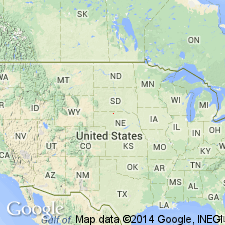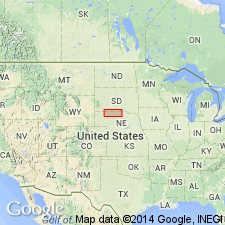
- Usage in publication:
-
- Crookston Bridge Member
- Modifications:
-
- Original reference
- Dominant lithology:
-
- Sand
- AAPG geologic province:
-
- Chadron arch
Summary:
Pg. 404, 406, pls. 22-24, fig. 16 (map). Crookston Bridge Member of Valentine Formation. Massive unconsolidated channel sand with numerous local lenses of greenish sandy clay. Thickness 150 to 175 feet. Present in north-central Nebraska and South Dakota (previously called "Bijou Quartzite" by Skinner and Taylor, 1967, Amer. Mus. Nat. Hist. Nov., no. 2300). Underlies Devil's Gulch Member of Valentine Formation; overlies Rosebud Formation (correlated). Fossils (vertebrates). [Age is Miocene.]
Includes Niobrara River fauna (Teilhard and Stirton, 1934, Univ. California Dept. Geol. Sci. Bull., v. 23, no. 8, p. 278); Valentine fauna (Johnson, 1936, Amer. Jour. Sci., v. 31, p. 471); Crookston Bridge local fauna (Schultz and Stout, 1961, Univ. Nebraska Spec. Pub., no. 2, fig. 3).
Type section: Crookston Bridge quarry, one-eighth mi below confluence of Snake and Niobrara Rivers, in SW/4 NW/4 sec. 1, T. 32 N., R. 30 W., northern Cherry Co., central northern NE. (= section published by Johnson, 1936, Amer. Jour. Sci., v. 31, fig. 2.)
Source: Publication; US geologic names lexicon (USGS Bull. 1520, p. 75).

- Usage in publication:
-
- Crookston Bridge Member
- Modifications:
-
- Areal extent
- AAPG geologic province:
-
- Chadron arch
- Salina basin
Summary:
Pg. 230 (fig. 3), 246 (fig. 4), 250-251 (fig. 5), 269-280. Crookston Bridge Member of Valentine Formation of Ogallala Group. Buff to gray, fine- to medium-grained, friable, cross-bedded channel sand, occasional layers of white siliceous root cast-bearing sandstone, and greenish gray clay. Thickness 96 to 175 feet. Is middle member of Valentine Formation; underlies Devil's Gulch Member and overlies Cornell Dam Member (new). Contains principal aquifer. Fossils. Includes vertebrate Niobrara River fauna, Railway Quarries local fauna, and Crookston Bridge local fauna. Age is middle Miocene (Valentinian NALMA; Barstovian NALMA of some paleontologists). [On p. 252, authors state Valentinian is applied to faunas that occur in the Valentine Formation and the Valentinian represents a period of possibly 3 m.y. duration. Some paleontologists place the Valentine Formation in the middle Barstovian to early Clarendonian NALMA.]
Source: Publication.
For more information, please contact Nancy Stamm, Geologic Names Committee Secretary.
Asterisk (*) indicates published by U.S. Geological Survey authors.
"No current usage" (†) implies that a name has been abandoned or has fallen into disuse. Former usage and, if known, replacement name given in parentheses ( ).
Slash (/) indicates name conflicts with nomenclatural guidelines (CSN, 1933; ACSN, 1961, 1970; NACSN, 1983, 2005, 2021). May be explained within brackets ([ ]).

